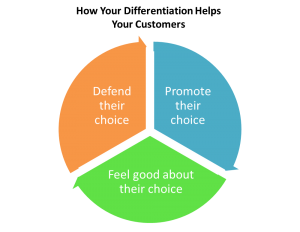How many times have you heard someone say “we are in a commodity market; times are getting tough and we can’t differentiate”?
In a world where no one can restrict your access to your customers, differentiation is always possible. Differentiation simply means that you do something differently that your customers can relate to and appreciate.

Differentiation is imperative to create because it helps the customers:
- Defend their choice
- Promote their choice
- Feel good about their choice
Real differentiation can be either tangible or intangible. Tangible is when your product is different, and intangible is when the customer “feels” it, although the underlying products may really be the same. Both kinds of differentiation will work together to create the total value proposition.
Here’s a simple checklist I came up with to define differentiation:
1. There is a clear linkage to how it benefits the target customer segments
If you claim something about your business, or your product, it’s obvious that it clearly ties in with why it matters for your customers.
2. It’s easy to convey to the target segment
A great differentiation should be easy to relay. Think about a bank that talks about excellent customer service, innovation, passion for making a difference. Well, everyone is saying the same thing! Make the differentiation more tangible, or let’s face it. You’re kidding yourself. You might feel excited talking about it inside the organization, but your customers won’t be feeling the same.
3. Not many other people can claim the same (ideally none)
Your customers will always ask, “how are you different from x”. Granted, they may not ask you directly but most likely they’ll think about it, and ask others as well. But that’s enough for you to anticipate this question. Sometimes, it may be easy for you because your competition may not be operating in your territory yet, or the customer may not be thinking about them, but you can’t bank on that forever. You must continue to strive to create points of differentiation.
Even companies like P&G & L’Oreal can’t get away without this. Even though they have the “quality”& “image” differentiators, they are still engaged in price and promotion wars with their few competitors. When you are fighting for mass reach, that’s an outcome to be expected; but it will be great to have a platform that’s just yours.
4. It can be executed and sustained well (operational processes)
Differentiation cannot be superficial, or it won’t matter. Customers must see a “proof point”. To be really driven home, differentiation must be supported by your marketing, your messaging, your product, you service and everything that touches the customer.
5. It won’t limit future plans on product line or geography expansions
This is an important one and often misunderstood primarily because of the similarity with branding & brand extensions. In most cases, your brand over time will be built through your performance – quality, service, messaging etc. And there always comes a time when you grow bigger, your customer segment changes, or your original geographic boundaries evolve.
It seems to be that what may have appealed to your smaller customers or to your local customers may not appeal to the bigger ones. But that’s a myth.
I call this confusion “The loss of the founder’s passion”. If what you have doesn’t appeal to the segment anymore, then where is your core differentiation. Instead, what most companies do is to dump the great thing they have, and try to copy their competitors. And then they get lost in the shuffle. They become just one more crab in the box.
6. It links all our products together so that value propositions are integrated
This last item (and the one before that) may appear to be a little surprising, but is the mainstay of the modern economy. In the modern digital economy, the biggest differentiation could very well be that you don’t define your strategy and customer experience by product, geography or any other such classification. Instead you think of the total customer ecosystem and stack your offerings according to the needs spectrum, and make conscious choices about the gaps that remain. Here, more than the product, the differentiation of your organization’s philosophy comes into play, and then percolates down to the products. An organizations are always built with a passion, to address a need. If you have multiple products or business lines, it’s always a good idea to put them to the test of the organization’s philosophy.
Understanding differentiation from niches
It must be noted that differentiation and niche are two different beasts. By doing more in fewer areas, you can achieve specialization and expertise, but you must still take specific steps to differentiate yourself in this more narrowly defined market. Operating in a niche is a strategic choice which depends on several factors. But whatever your niche, chances are that you won’t be the only one for too long. Hence it is important to create those differentiation factors that address the all-important question – why should I choose you over others.
Read more about this and the other 4 principles in my book :”Dancing the Digital Tune: The 5 Principles of Competing in a Digital World“.
